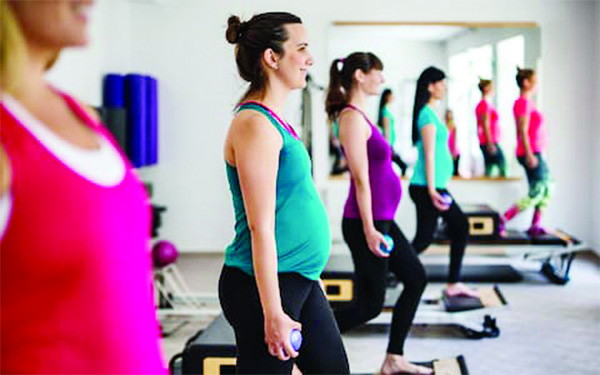
Weekend Plus Desk :
A woman’s body undergoes a lot of change during pregnancy. However, these changes differ from person to person, depending on their bodies. Some symptoms of pregnancy last for several weeks or months, while other discomforts are temporary or don’t affect all women. Divided into three trimesters, a normal pregnancy lasts for about 40 weeks.
Most women these days like to keep themselves fit even during pregnancy. If you are one of those, then follow these exercises, as suggested by certified personal trainer Tavdeep Singh, founder, Deep Fitness Studio to keep your body moving.
First trimester
A woman undergoes a lot of hormonal changes during the first trimester, during which the foetus grows inside the body.
Women may experience morning sickness, nausea and vomiting and may even feel more tired and urinate more frequently.
As the digestive system gets slower, to increase the absorption of beneficial nutrients during the first trimester, exercise is very important.
However, women can do only light exercises like stretches and light aerobics at this time. Aerobic exercise strengthens the heart and lungs and helps maintain the muscle tone. Low-impact aerobics includes more of lower body stretches and stationary cycling.
Second trimester
The changes in the body become visible in the second trimester. The foetus can hear during this stage and it is very important to increase the heart rate steadily and improve blood circulation. It is equally important to keep the body flexible and strong, control healthy weight gain, prepare the muscles for labour and birth. Exercising during pregnancy can help shorten the labour process, increase the chances of a natural birth, and reduce the risk of hypertension.
Ideal weekly schedule
Day 1 – Lower body: Assisted squats, step-ups, leg extensions, calf raises.
Day 2 – Upper body: Assisted bench barbell press, lat-pull down, shoulder lateral raises, barbell curls, pulley-push down.
Day 3 – Cardio: 15 minutes brisk walk, 10 minutes static cycling, 7 minutes cross trainer.
Day 4 – Rest
Day 5 – Lower body: Repeat
Day 6 – Upper body: Repeat
Day 7 – Rest
Third trimester
The third trimester is very important as a woman experiences swelling in the hands, feet, and face as there is more water retention in the body. Pain in the back, hips and pelvic area increases as the body prepares for delivery. The foetus kicks and stretches at this time. The baby takes the position as the head starts getting towards the pelvic area.
During this time, squatting may help to open the pelvis, so it may be a good idea to practice it. Stand with the feet flat on the floor, shoulder-width apart, and the back straight. Lower yourself slowly, keeping your feet flat and your knees no further forward than your feet. Hold for 10 to 30 seconds, and then slowly push up.
When exercising:
*Avoid exercising in high humidity.
*Avoid heavy weightlifting.
*Avoid exercises of abdomen.
*Never exercise if you are too exhausted.
A woman’s body undergoes a lot of change during pregnancy. However, these changes differ from person to person, depending on their bodies. Some symptoms of pregnancy last for several weeks or months, while other discomforts are temporary or don’t affect all women. Divided into three trimesters, a normal pregnancy lasts for about 40 weeks.
Most women these days like to keep themselves fit even during pregnancy. If you are one of those, then follow these exercises, as suggested by certified personal trainer Tavdeep Singh, founder, Deep Fitness Studio to keep your body moving.
First trimester
A woman undergoes a lot of hormonal changes during the first trimester, during which the foetus grows inside the body.
Women may experience morning sickness, nausea and vomiting and may even feel more tired and urinate more frequently.
As the digestive system gets slower, to increase the absorption of beneficial nutrients during the first trimester, exercise is very important.
However, women can do only light exercises like stretches and light aerobics at this time. Aerobic exercise strengthens the heart and lungs and helps maintain the muscle tone. Low-impact aerobics includes more of lower body stretches and stationary cycling.
Second trimester
The changes in the body become visible in the second trimester. The foetus can hear during this stage and it is very important to increase the heart rate steadily and improve blood circulation. It is equally important to keep the body flexible and strong, control healthy weight gain, prepare the muscles for labour and birth. Exercising during pregnancy can help shorten the labour process, increase the chances of a natural birth, and reduce the risk of hypertension.
Ideal weekly schedule
Day 1 – Lower body: Assisted squats, step-ups, leg extensions, calf raises.
Day 2 – Upper body: Assisted bench barbell press, lat-pull down, shoulder lateral raises, barbell curls, pulley-push down.
Day 3 – Cardio: 15 minutes brisk walk, 10 minutes static cycling, 7 minutes cross trainer.
Day 4 – Rest
Day 5 – Lower body: Repeat
Day 6 – Upper body: Repeat
Day 7 – Rest
Third trimester
The third trimester is very important as a woman experiences swelling in the hands, feet, and face as there is more water retention in the body. Pain in the back, hips and pelvic area increases as the body prepares for delivery. The foetus kicks and stretches at this time. The baby takes the position as the head starts getting towards the pelvic area.
During this time, squatting may help to open the pelvis, so it may be a good idea to practice it. Stand with the feet flat on the floor, shoulder-width apart, and the back straight. Lower yourself slowly, keeping your feet flat and your knees no further forward than your feet. Hold for 10 to 30 seconds, and then slowly push up.
When exercising:
*Avoid exercising in high humidity.
*Avoid heavy weightlifting.
*Avoid exercises of abdomen.
*Never exercise if you are too exhausted.

